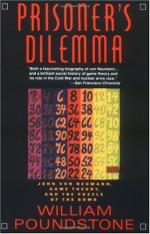|
This section contains 580 words (approx. 2 pages at 400 words per page) |

|
Chapter 3 Game Theory Summary and Analysis
The game Kriegsspiel was developed in the eighteenth century as a game to be used in military academies to train officers for war. The game became very popular among the Prussians during the nineteenth century, so popular, in fact, that the Prussian command issued a game to every regiment and officers were required to play the game. Unlike chess, Kriegsspiel is an imperfect information game. The players are unable to see their opponent's pieces and, hence, must infer where their opponent is. Von Neumann played Kriegsspiel as a boy and apparently the game was popular in the lunch rooms of the IAS.
Game theory is a theory of games like Kriegsspiel. Chess, like tic-tac-toe, is a game that has a certain determinate decision space based on the possible moves of the pieces and size of the board...
(read more from the Chapter 3 Game Theory Summary)
|
This section contains 580 words (approx. 2 pages at 400 words per page) |

|




